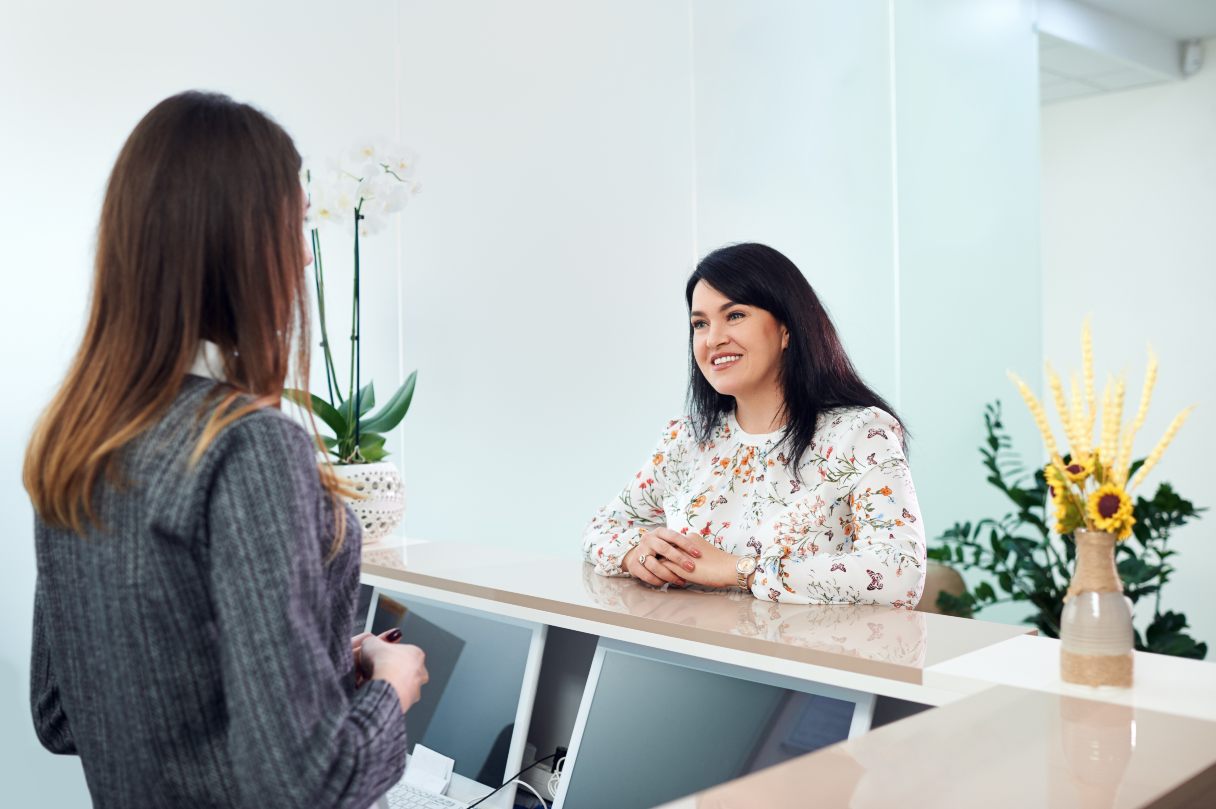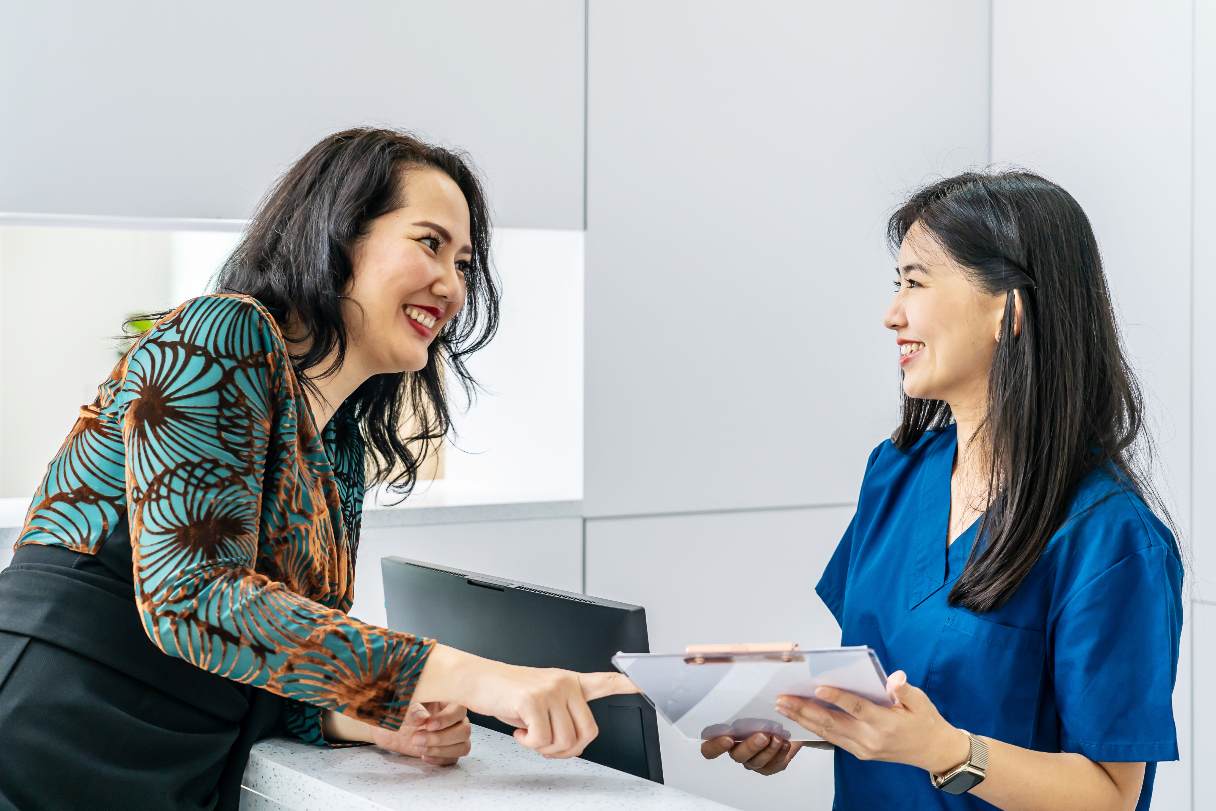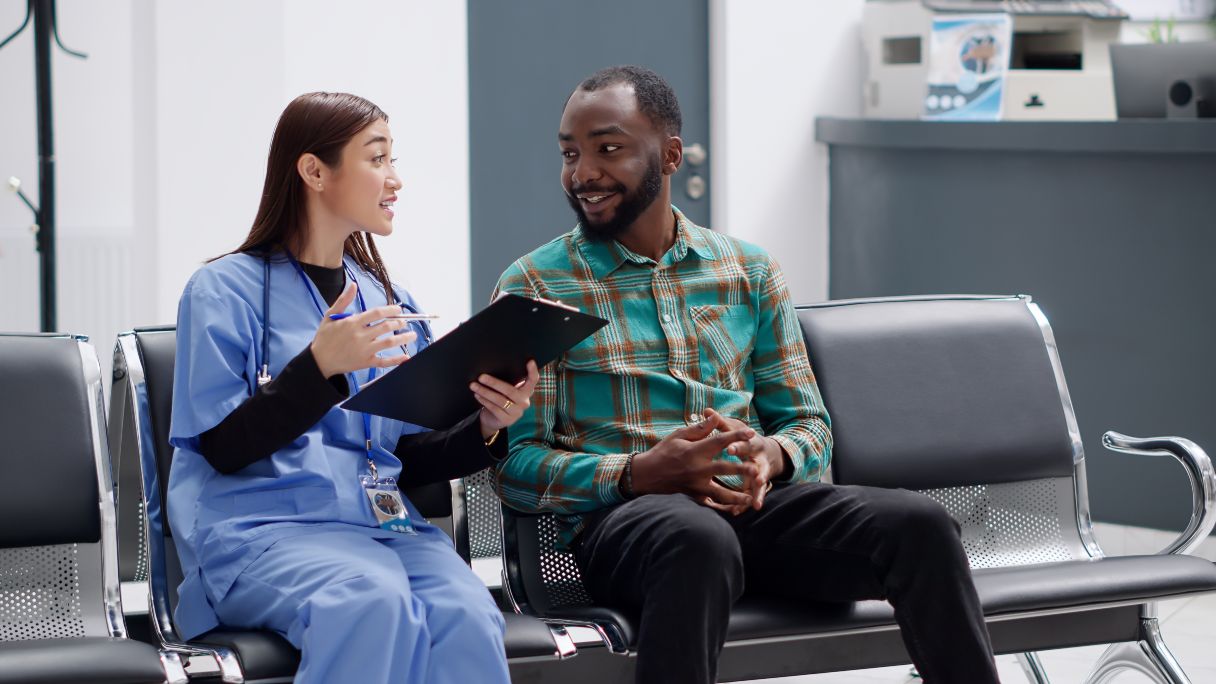Mastering the Initial Patient Contact and Pre-Appointment Conversation
Learn tips from health and wellness providers for building trust and creating a smoother patient or client experience at the start of their care journey.
By Synchrony, Health & Wellness
Posted Dec 20, 2024 - 10 min read

First impressions can make or break a patient-provider relationship. That’s why it’s important for health and wellness practices to lay the right foundations with their patients and clients from the start of the patient journey. This includes the patient’s or client’s first encounter with the practice (whether that is in person, over the phone or online), as well as at every point of client or patient communication that follows.
At CareCredit, we had a roundtable discussion with a group of clinician-owners about how they lay a strong foundation for a positive patient experience through the initial interaction with the patient and pre-appointment communication.
Glean patient experience and patient relationship-building tips from ophthalmologist Dr. Ehsan Sadri, dentist Dr. Howard Ong and retired audiologist Nola Aronson, M.A., CCC-A. (Nola Aronson was practicing at the time of this roundtable interview.)
Setting the Stage for a Positive Patient Experience
Can you share your goals and desires when it comes to the patient experience in your practice?
Aronson: The overall goal of our patient experience is to make patients feel comfortable and understand that we are here to help in any way we can with their hearing concerns. Our patient experience starts with an introduction to our front-office receptionist. Then the patient is escorted to our waiting room where they can read some literature and enjoy some coffee, candy and other treats.
We have a video playing in the background that explains hearing loss and new technology — hopefully educating the patient while entertaining them at the same time. When it’s time to see the provider, it’s our hope that they are comfortable and informed about hearing loss and what they can expect from their visit to our office.
Dr. Sadri: Like Ms. Aronson, we really focus on educating our patients about the latest updates and innovations in eye care. We also use video and written content to provide patients with as much relevant information as we can prior to their exam, so that their visit with the doctor is as efficient and effective an experience as possible.
Dr. Ong: Our patient experience is directly linked to our practice culture, which we define through our relationship-building skills. We feel the best way to gain initial trust and confidence is to take the time to simply speak to, visit and honestly connect with patients. Once that initial relationship is established, everything else follows — from educating patients and instilling confidence in our treatment recommendations to having patients accept and follow through with care.
We personally go out and greet every patient and walk them into our practice. Little things like that are just part of our practice culture and go back to treating patients like we would want to be treated.
Is the patient experience something that you and your team purposefully craft and continually update?
Dr. Sadri: Yes, we routinely craft and update our messaging to the patient. I think an informed patient is a powerful patient who can ask proper questions and understand and take part in their own care. Also, an informed patient is typically more motivated to move forward with their procedure or care goals.
With the advent of the internet and all the different information that’s available today, patients are really savvy. While I definitely think it’s important that we as clinicians control the dialogue from a healthcare provider’s standpoint, as far as I’m concerned there’s no such thing as an over-informed patient.
Dr. Ong: I would agree with that. Our major focus is relationship-building, which can be hard to monitor, but one of the things we do to stay up-to-date with what’s happening with our patient experience is to have regular meetings. We divide our practice into different teams and meet as a group at least once a month.
During that time, we talk about relationship-building. We make sure that every team member understands that this is the single most important tool we have to create a positive patient experience.
Aronson: Similar to what Dr. Ong said, we have clinic meetings where we go over what’s going on with each patient. If we’ve had any problems with a patient, we try to determine why, what happened, what was said to the patient, what we can do to rectify the problem and what we can learn from it so that it doesn’t happen again.
Best practices for creating a positive patient experience:
- Make sure the front office staff makes patients and clients feel welcome and supported.
- Provide a comfortable waiting room with educational content available (literature and videos).
- Make a genuine effort to connect and interact with the patient.
- Reflect with your team on how to improve the patient experience.
Getting It Right at the Initial Point of Contact
What are your practice’s first points of contact with the patient?
Dr. Ong: These days, it’s the internet or our social media platform. Patients are definitely checking us out online before contacting us. In fact, we had several new patients come in this past month, and when we asked how they heard about us, more than half said they found us on social media, through Yelp or Facebook or on some other form of digital media.
We actually have a review system that automatically generates a request to patients after their visit. Once they’ve completed a review, we get their permission and then post it on our Facebook page and other social media platforms. That seems to be the primary way that many of our new patients are prompted to call, come by or make an appointment.
Aronson: I’m personally very involved in my community. Although it has 330,000 people, it’s very tight-knit. My husband does all the marketing for our practice, and he and I belong to several networking groups. I’m also on the board of directors of two nonprofits here, so when people see our ads and other marketing materials, I think they feel like they already know, like and trust us because of how much we’re out there in the community.
You can’t just sit behind your desk. People work with people they know and trust and so that’s how we’ve built up our business — by being out there. In addition to advertising in about four different papers, I’m also on a radio show for the senior hour once a month. So when people come to our practice, most of the time they say, “Oh, we see you everywhere. We feel like we know you already.”
Something we just started is a physician newsletter. We also have a patient newsletter that we email out. And of course, we have our website which is continually evolving. We put open house events that we have once a month on the website for people to see and there’s a place for someone to sign up for a free hearing guide. We offer free hearing screenings to the entire community to get people into the door as well.
We also recently started making videos. Most of them are informational because when somebody comes to your page, you want to look like an expert who knows everything so that they’re not looking around at different websites. So we have different short videos that say how to take care of your hearing aid, how to clean your hearing aid, what happens when you need a hearing aid, you know we have a video on tinnitus — just whatever we can think of that people would be interested in.
Dr. Sadri: Our initial point of contact with patients usually comes through the phone, the internet or a primary care or optometry referral. Typically, the patient calls in for an appointment with the provider. Then my team sends them a packet of information to review and forms to fill out so that when they come in, they have a clear understanding of what to expect at their appointment.
As you said, Dr. Sadri, often the first point of contact is an incoming phone call. How critical a step is this first person-to-person contact in the patient’s journey?
Dr. Sadri: It’s extremely critical. If a patient calls in and has to deal with long wait times, dropped calls or a short or unmotivated team member, it simply kills the patient’s confidence in the practice. On the other hand, if a patient experiences a pleasant greeting from a caring staff member with no wait or hold time, and they are able to schedule an appointment within a reasonable timeframe, they are far more likely to have a positive impression of your practice and keep their appointment.
I think phone skills are like any other people skills: you have to be empathetic and come from a place of care and comfort for the patient.
Dr. Ong: I agree, and I’m happy to say our admin team is exceptional about welcoming patients over the phone. They take the time to walk new patients through our digital media, inputting their data online so when they come to our practice, they are ready.
Our team also uses the initial phone call to really try to get to know the patient and determine their needs by asking questions that go beyond “How did you hear about us?” They ask about everything from the level of anxiety the patient may feel while undergoing treatment to the best time to schedule an appointment to eliminate conflicts. Those secondary or tertiary questions help to set the patient up for success and limit disappointments.
When it comes to phone skills, I think a lot has to do with training. We meet and work on telephone training with our team every month. We discuss talking points and if there’s been any feedback from patients — positive or negative.
We also use scripts — although, after hundreds of phone calls, all of our admins know exactly what to say by now. But for those who are just beginning or looking to improve their telephone skills, I recommend starting with a script because you don’t want to have a boring or meandering conversation with a patient that goes nowhere.
You definitely want to be scripted and specific with those secondary, tertiary questions I was talking about so that you’re capturing all the relevant information and so the admin knows what they’ve talked about with the patient when they meet them for the first time.
Aronson: That’s a great idea, Dr. Ong. One of the things we do to maintain our phone skills is to have secret shoppers call our office and give us feedback on what happened during the call. I also work with a company that records our phone calls so that I listen to them — especially the missed opportunities — and see what’s happening and how the phone calls are being answered.
We also do a lot of role-playing to make sure that first point of contact is really friendly on the phone. And we train our team to really listen to what the person is saying, and we practice how to answer correctly. Because if you don’t answer the questions right or you try to give prices over the phone or things like that, then the patient’s going to go shopping around and looking around — or if they don’t feel comfortable, they’re not going to make an appointment. So I think that first point of contact is one of the most important people in your office.
Best practices for the initial points of contact with the patient or client:
- Have a strong online presence (website, social media, review sites, etc.).
- Be active in your local community (networking, local nonprofits, community events, etc.).
- Provide helpful content (newsletters, videos, guides, etc.).
- Train the team on their phone skills (try role-playing) and provide scripts for guidance (how to greet a patient, questions to ask, etc.).
- Evaluate staff phone conversations (via recorded calls, secret shoppers, etc.) and identify potential areas for improvement.
Pre-Appointment Communication: Creating a Smooth Transition Into Care
The next step in the patient journey is pre-appointment communication. What do you do to continue the experience before the patient arrives at the practice?
Aronson: In our follow-up with the patient, we have a patient input form that the front office fills out that has certain questions to ask the patient about their hearing and what they’re experiencing so that we can determine how to schedule the appointment appropriately and give enough time for the provider to be able to do things right. We also have our team member ask for a third party to attend the appointment with the patient. They also use this conversation to ask the patient specific questions like, “What problems are you having?” “Do other people notice those problems, too?” “How long have you had those problems?”
Finally, to ensure that the patient shows up for their appointment, we do various things to confirm. We have a system that will email the patient a week before their scheduled appointment. Then we will email or text the patient to remind them a few days before, and then our office staff will call the day before to confirm. We have a very low no-show rate. In fact, the only time we have a no-show is when it’s raining outside.
Dr. Sadri: After the initial contact, we have patients go to our website and fill out the necessary forms. Then they have a conversation with a counselor and a front office person to see what they’re coming in for and how urgent it is and to provide them with educational materials upfront. So if they are coming in for LASIK, we want to educate them about the procedure as much as possible upfront. If they’re coming in for cataracts, we want to do the same thing.
How we present the information to our patients depends on the demographic and the age. If they prefer email, we will send them materials that way. A lot of our patients still like the traditional mail, especially older patients, so we often use that method. Once they get the materials, we ask the patient to review them and contact us with any questions.
We find that patients who have engaged with the information come in more educated and knowledgeable about the procedure and feel more comfortable. If they didn’t review the material, it’s pretty obvious. When that happens, the first appointment becomes an informational appointment, and then they have to come back for a follow-up — which is fine, but it’s not as efficient as the patients who come in already having the basic knowledge about their treatment.
Dr. Ong: During our confirmation phone call, we always make sure that the patient knows which member of our team they are talking with. Then once they come in we make it a point to introduce them to the team member who initially had that phone conversation with them so they have a point of contact. That connection helps solidify and strengthen the patient experience.
We also take the information we gathered in that initial conversation and put it into their chart before we actually see the patient so the whole team — doctors and assistants — is aware of some of the conversations we’ve had with the new patient. We leverage those notes when the patient comes, using them as bullet points during the chairside conversation.
You can literally see their eyes light up when they realize that someone was paying attention, and as a result, we now have a solid foundation on which to start a relationship.
Best practices for pre-appointment communication:
- Use pre-appointment forms to capture information needed for the appointment.
- Send reminders via email, text and/or phone prior to the appointment.
- Provide educational materials to help the patient or client prepare for the appointment.
- Log what was discussed in initial patient communications so the care team can reference this going forward.
Offering Flexible Financing at Your Practice
If you are looking for a way to connect your patients or clients with flexible financing that empowers them to pay for the care they want and need, consider offering the CareCredit credit card as a payment option. CareCredit allows cardholders to pay for out-of-pocket health and wellness expenses over time while helping enhance the payments process for your practice or business.*
When you accept CareCredit, patients or clients can see if they prequalify with no impact to their credit score, and those who apply, if approved, can take advantage of special financing on every qualifying purchase.* Additionally, you will be paid directly within two business days.
Learn more about the CareCredit credit card as a financing solution or start the provider enrollment process by filling out this form.
Expert Bios
Dr. Howard Ong
Dr. Howard Ong, M.A.G.D., is a general dentist located in Seal Beach, California, who specializes in dental implants. Due to his extensive training, he handles all surgery cases for the practice and is a proponent of using cutting-edge technology in the office. Dr. Ong is a member of, and holds a Masters credential from, the International Congress of Oral Implantologists and from the Academy of General Dentistry. He is also a member of the American Dental Association, California Dental Association, Harbor Dental Society and Seal Beach Dental Study Club.
Nola Aronson
Nola Aronson received a bachelor’s degree in special education from the University of Hartford in 1975 and taught until 1981 with many types of disabled children. She then received her master’s degree in audiology from California State University, Long Beach in 1982. Nola holds certifications of clinical competence from the American Hearing and Speech Association and the American Academy of Audiology. She practiced audiology in Los Angeles County for 39 years until her retirement in 2022, when she sold her practice.
Dr. Ehsan Sadri
Ehsan Sadri, M.D., FACS, FAAO is board-certified and fellowship-trained in cataract surgery, LASIK and glaucoma surgery. As a top ophthalmologist and cataract surgeon, Dr. Sadri has delivered over 300 invited lectures both nationally and internationally in which he teaches other eye surgeons the latest techniques for vision correction and preservation. His clinical and research work has earned him numerous honors and grants. He is also continually listed in Best Doctors in America®, Best Doctors in Southern California and America’s Top Ophthalmologists.
Healthcare payment and financing solution
The CareCredit health and wellness credit card helps improve the payment experience for patients and clients, and your financial performance.
Get StartedReady to help more patients and clients get the care they want and need?
Get StartedReady to help more patients and clients get the care they want and need?
Get Started* Subject to credit approval.
The information, opinions and recommendations expressed in the article are for informational purposes only. Information has been obtained from sources generally believed to be reliable. However, because of the possibility of human or mechanical error by our sources, or any other, Synchrony and any of its affiliates, including CareCredit, (collectively, “Synchrony”) does not provide any warranty as to the accuracy, adequacy or completeness of any information for its intended purpose or any results obtained from the use of such information. All statements and opinions in this article are the sole opinions of the author. The data presented in the article was current as of the time of writing. Please consult with your individual advisors with respect to any information presented.
© 2024 Synchrony Bank.




